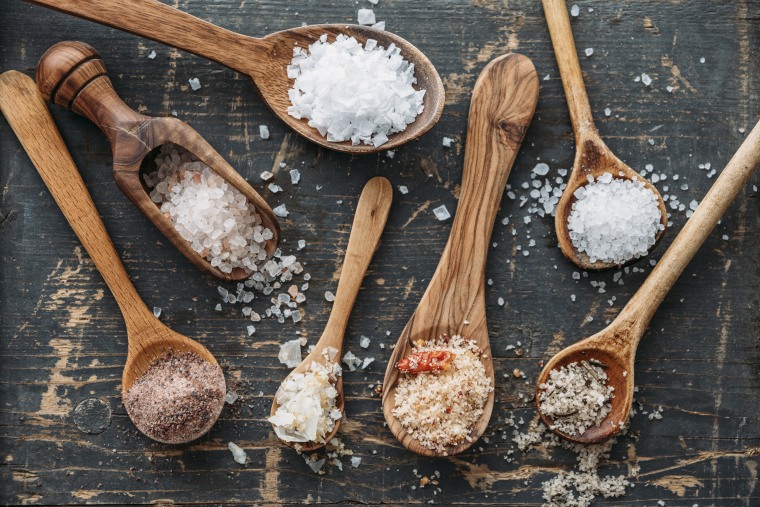Salt is one of the most common ingredients used in cooking and manufacturing food, but finer (and pricier) sea salt and Himalayan salt have risen in popularity, partly because they’re less processed and people equate natural with healthy. A quick Google search on the healthfulness of these more natural salt varieties produces some wild claims. (Apparently, sea salt can help regulate blood pressure and treat chronic fatigue syndrome.)
But before you grab the salt shaker, here’s what you need to know about popular varieties on the market.
Sea Salt
As its name implies, sea salt is derived from sea water. Like other less processed foods, it retains more nutrients — in this case, minerals, such as magnesium, potassium and calcium—and these minerals add to the brighter color and purer flavor of sea salt. You can find sea salt from small, specialty brands as well as larger, mainstream brands, and ironically, because of consumer interest in more natural ingredients, manufacturers are now adding sea salt to packaged snacks, like potato chips! In addition to the natural minerals it has, sea salt may have one unexpected ingredient. According to a recent study, most brands of sea salt contain tiny plastic particles that come from larger plastic debris, which pollute the water that sea salt is derived from. We don’t yet know the impact of these plastic microparticles on our health, but my hunch is they’re not good for us.
Himalayan Salt
Himalayan salt is the pink, eye candy of the salt aisle. You may find it sold in beautiful, marbled pink slabs, though it’s also found in salt grinders and canisters. It’s mined in the Himalayans, and the color is said to be due to the mineral content, which may include copper, magnesium, potassium and others.
Table Salt
Table salt, often derived from salt mines, is more heavily processed, and much like other processed foods, is stripped of its natural minerals. However, manufacturers may add iodine to table salt — a practice that began in the 1920s in order to correct for iodine deficiency. Iodine is another mineral and it’s critical to the production of thyroid hormones; a deficiency may result in an enlarged thyroid (known as goiter). As other forms of salt have become increasingly popular, you may also find some mainstream brands that enrich additional salt varieties with iodine.
Kosher Salt
This is kind of like an in-between salt. It’s more processed than sea salt (and thus, retains fewer minerals), but the salt crystals are coarser than table salt, which is why it’s a preferred choice for many cooks — you can easily grab a pinch to season food.
Which Salt Is Healthiest?
Don’t get swayed by claims of salt’s healthfulness. “Salt is salt is salt, whether it’s pink or white or in tiny crystals or large flakes — it’s not good for us, and sea salt is no more healthy than table salt in terms of its effect on blood pressure and heart health” says Dr. Suzanne Steinbaum, cardiologist at The Mount Sinai Hospital and volunteer medical expert for American Heart Association’s Go Red for Women. The main difference is in the size of the flakes. Bigger crystals from sea, Himalayan and kosher salt take up more room in your measuring spoon so if you measure your salt versus salting to taste, you may take in a little less, she says. “The question isn’t about what type of salt is being used, it’s about how much is being used. The upper target is 2,300 mg, no matter what the source.”
Salt is salt is salt, whether it’s pink or white or in tiny crystals or large flakes.
Most Americans are over-consuming sodium — mainly because over 70 percent of it is supplied in packaged foods, so we have no control over the amount that’s used. It may seem surprising, but according to the American Heart Association, the leading source of sodium in our diets is bread. Pizza holds the number two spot.
The latest government data suggest that most people are consuming sufficient iodine in their diets, so whether or not you get this mineral from salt doesn’t seem to be much of a concern these days. (Pregnant women have higher iodine needs than most people, and therefore, should check in with their doctor about the best way to meet their daily demands.) As for the mineral content of more natural sea and Himalayan salts, don’t count on them as a good source of their hyped-up mineral content; the amount they provide is miniscule in comparison to foods, like veggies, fruits, beans, nuts and whole grains.
Instead of focusing on the type of salt you use, try eating less of it in general. You can do that by adding herbs and spices to dishes you make at home, but you’ll get an even bigger impact bringing down your daily sodium levels (and therefore, your blood pressure) by replacing packaged foods with whole foods and cooking more than you dine out.
MORE HEALTHY EATING ADVICE
- What four nutritionists eat in a day
- How to eat pizza, according to a dietitian
- Bad nutrition advice dietitians want you to forget
- The best way to lose weight boils down to these three things
- What you need to know about going vegan
Want more tips like these? NBC News BETTER is obsessed with finding easier, healthier and smarter ways to live. Sign up for our newsletter and follow us on Facebook, Twitter and Instagram.

